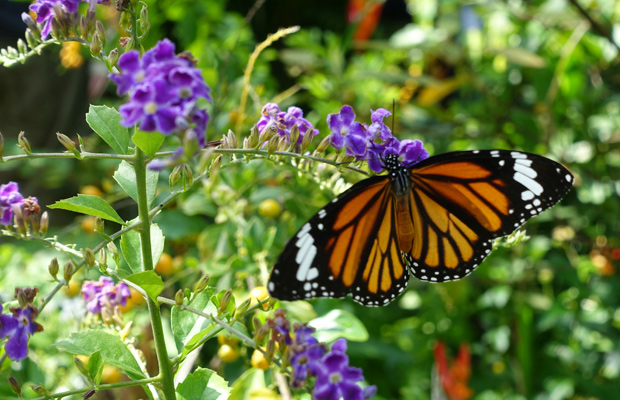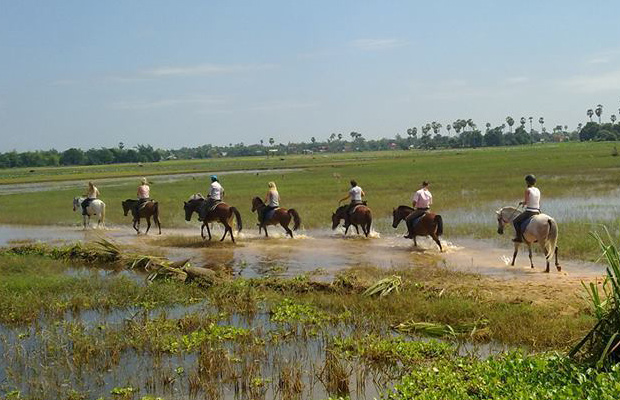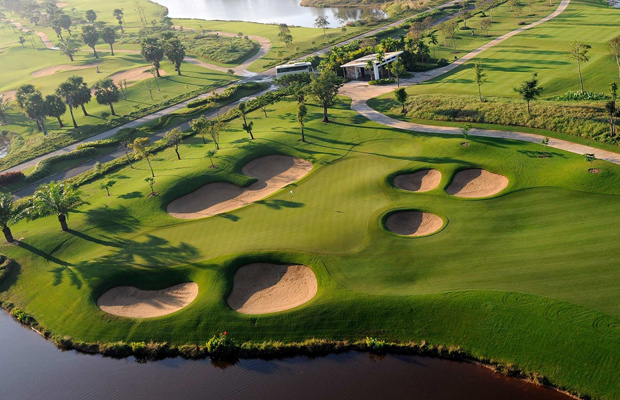Share this with your friends & families
Ta Prohm (Khmer: ប្រាសាទតាព្រហ្ម, pronunciation: prasat taprohm) is the modern name of the temple at Angkor, Siem Reap Province, Cambodia, built in the Bayon style largely in the late 12th and early 13th centuries and originally called Rajavihara (in Khmer: រាជវិហារ). Located approximately one kilometre east of Angkor Thom and on the southern edge of the East Baray, it was founded by the Khmer King Jayavarman VII:125[2]:388 as a Mahayana Buddhist monastery and university. Unlike most Angkorian temples, Ta Prohm is in much the same condition in which it was found: the photogenic and atmospheric combination of trees growing out of the ruins and the jungle surroundings have made it one of Angkor's most popular temples with visitors. UNESCO inscribed Ta Prohm on the World Heritage List in 1992. Today, it is one of the most visited complexes in Cambodia’s Angkor region. The conservation and restoration of Ta Prohm is a partnership project of the Archaeological Survey of India and the APSARA (Authority for the Protection and Management of Angkor and the Region of Siem Reap).
Layout of Ta Prohm Temple
Ta Prohm is among the largest of the monuments in the Angkor complex, the in scrimption gives an idea of the size of the temple. The complex included 260 statues of gods, 39 towers with pinnacles and 566 groups of residences. Ta Prohm comprises a series of long low buildings standing on one level, which are enclosed by rectangular laterite wall (600 by 1,000 meters, 1,959 by 3,281 feet). Only traces of the wall are still visible. The center of the monument is reached by a series of towers connected with passages. This arrangement forms a ' sort of sacred way into the heart of the monument’; three-square galleries enclose the area.
Foundation and expansion
In 1186 A.D., Jayavarman VII embarked on a massive program of construction and public works. Rajavihara ("monastery of the king"), today known as Ta Prohm ("ancestor Brahma"), was one of the first temples founded pursuant to that program. The stele commemorating the foundation gives a date of 1186 A.D.
Jayavarman VII constructed Rajavihara in honour of his family. The temple's main image, representing Prajnaparamita, the personification of wisdom, was modelled on the king's mother. The northern and southern satellite temples in the third enclosure were dedicated to the king's guru, Jayamangalartha,:174 and his elder brother respectively. As such, Ta Prohm formed a complementary pair with the temple monastery of Preah Khan, dedicated in 1191 A.D., the main image of which represented the Bodhisattva of compassion Lokesvara and was modelled on the king's father.
The temple's stele records that the site was home to more than 12,500 people (including 18 high priests and 615 dancers), with an additional 800,000 souls in the surrounding villages working to provide services and supplies. The stele also notes that the temple amassed considerable riches, including gold, pearls and silks. Expansions and additions to Ta Prohm continued as late as the rule of Srindravarman at the end of the 15th century.
CENTRAL SANCTUARY of Ta Prohm Temple
Follow the plan and walk through the Central Sanctuary, recognizable by its undecorated interior. The stone has hammered, presumably to apply a coating probably of paint or gilt. Evenly spaced ' holes in the wall from floor to ceiling suggest a covering of wood, stucco or metal.
Walk across the central courtyard towards the left (northeast) and through the door of a gallery that is framed by the roots of a tree. Turn left and walk through a dark passageway and a courtyard. Enter the aisle with pillars, turn right, walk straight between twin towers and to the right into a very narrow passage which houses the inscription of the temple. Return by the same passage, turn right and continue straight, passing through a vestibule. The false doors on the north and south sides of the large rectangular enclosure with high walls are finely decorated. There are four small courts with galleries and pillars (12). Ritual dances may have been performed in this area.
Walk across the courtyard and into the entry tower of the enclosing wall, at the east entrance. It is in the shape of a cross with pillars on the interior, four wings and two passages on the side. The walls of these passages are decorated with relief. To the left there is a hall with pillars placed close together. They probably provided the base for a structure built of wood. Beyond are small rectangular cells, which surround the exterior of Ta Prohm.
One leaves Ta Prohm by a path (400 meters, 1,32 feet long) leading to the exterior enclosure where section of the wall are visible.
So the temple is held in a stranglehold of trees. Stone and wood clasp each other in grim hostility; yet all is silent and still, without any visible movement to indicate their struggle as if they were wrestlers suddenly petrified, struck motionless in the middle of a fight, the rounds in this battle were not measured by minutes, but by centuries.
- Siem Reap
Ta Prohm's state of ruin is a state of beauty, which is investigated with delight and left with regret. Ta Prohm is locating southwest of the East Mebon and east of Angkor Thom. Its outer enclosure is near the corner of Banteay Kdei. It can be accessed by enter the monument from the west and leave from the east entrance.
Other Travelstyle
- Small Group Tours (Siem Reap, Phnom Penh, Sihanoukville)
- Private Day Tours (Siem Reap, Phnom Penh, Sihanoukville)
- Multi-Day Tours
- Angkor National Park Tickets
- Transports and Transfer
- Angkor Excursions
- Siem Reap to Phnom Penh
- Battambang Excursions
- Phnom Penh Excursions
- From Phnom Penh
- Cambodia Tickets
Siem Reap Hotels
Siem Reap Tours
- Tonle Sap Lake and Kampong Phluk Private Half Day tour from Siem Reap
- 3-Day Angkor Wat Admission Ticket With a Car or Minivan
- Floating Villages and Beng Melea tour 2Days
- The Grand Circuit Tour 1Day
- Kulen Elephant Forest and Tonle Sap Lake From Siem Reap
- Angkor Wat Temples & Tonle Sap Lake Private Day Tour
- Small-Group Explore Angkor Wat Tour with Guide from Siem Reap
- Charity Vacations 7Days-6Nights
- Siem Reap Evening Street Food Tour
- Spirit Of Cambodia 14Days-13Nights
- Sambor Prei Kuk tour 1Day
- Rolous Group and Preah Khan - Private Day Tour






















